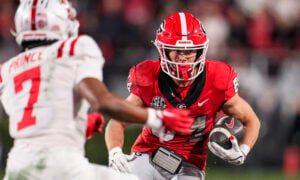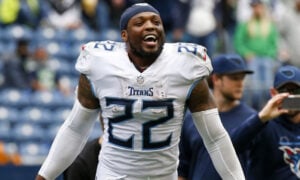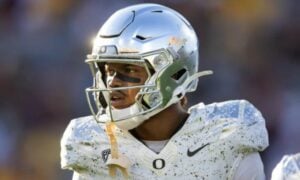2016 NFL Draft – First Look: Quarterbacks
 Just over two weeks ago, I started my first look (2016 NFL Draft) series with a look at the running backs. Now I’m turning my attention to the quarterback class.
Just over two weeks ago, I started my first look (2016 NFL Draft) series with a look at the running backs. Now I’m turning my attention to the quarterback class.
I don’t want to get carried away here with the quarterbacks. If you play in a super-flex (2QB) league, then obviously there’s going to be more emphasis on these rookies, but in all other formats, the quarterback will fall mightily in most cases unless there is a true headlining name such as Andrew Luck or, during that same year, Robert Griffin III. And we all know how that has turned out, at least thus far.
2016
[am4show have=’g1;’ guest_error=’sub_message’ user_error=’sub_message’ ]
2016 is a year with decent prospects but I have no problem parroting the professionals here in exclaiming that there isn’t a sure-fire first round talent in this class. That’s not to say that there aren’t quarterbacks that will be selected in the first round, and highly at that. When teams have a need at the position, they have learned that it’s far better to take the best the class has to offer rather than try to find that diamond in the rough which doesn’t usually pan out. To be sure, there are quarterbacks that I do like this year but am much more comfortable with the talent when selected later in the first of the NFL draft.
2016 does contain something that I do desire in my quarterbacks – size. With a move back to more prototypical passers seemingly underway, the size of this class plays well. One note to my last statement: mobility is still strongly desired but there is little doubt in my mind that this mobility factors more in escapability and elusivity from a pass-first mentality. Last year’s good looking rookies, Marcus Mariota and Jameis Winston, are good examples of this. Once breaking from the pocket, both keep their eyes downfield but have the ability to punish defenses that over-commit or lose contain.
For teams at the top of this draft, there exists enough intrigue with a few names such that you can expect at least two, and most likely three, to be taken prior to selection twenty, that is my expectation at least. If one thing has been obvious in recent years from NFL rosters, it’s that the upside non-starting quarterbacks currently waiting in the wings is less than impressive. Teams cannot afford to wait.
Let’s get to the players as one name this year does intrigue me greatly.
Quarterbacks
As mentioned previously, I’m looking for three slingers to be selected in the first round. Beyond that, we have other names that will provide upside. In fact, when looking at the class as a whole, I see a tight grouping of players of which any could rise to prominence within five years. If you were to tell me that my fifth or six ranked player were to be at the top of the class in a number of years, this year would carry little surprise. The size, ability and completion percentage, an important trait in my review of passers, of this year’s class provides depth.
Jared Goff
Cal
6’4/210 lbs.
There’s a lot to like with Goff. A quick-read (no longer pro-style), a live arm, good size and impressive intangibles provide a high ceiling. I like quarterbacks that progress year over year, especially in completion percentage, regardless of the loss of top offensive talent around him. Goff’s 64.5% rate and 43 touchdowns immediately puts him on the map. He has an effortless and quick release and can make all the throws in the NFL. His passing motion is fluid and his feet and hips provide a good launch mechanism for his passes.
Some question his weight but I’m not one of them. While I’d like to see him weigh in closer to 220 lbs., my feeling is that he’ll struggle to eclipse the listed 210. If his trainers are worth their weight, no pun intended, they’ve been working in the weight room to get into the teens. On the negative side, Goff doesn’t always spin a pretty ball and when his mechanics break down in the trash of a pocket, this can be an issue. Unlike most experts, I think Goff has a chance to be a more effective first-year starter in the right offense with a capable offensive line. He’ll need a lot of work from under center as most of his experience has been from the shotgun.
Many will prefer my second rated passer over Goff and I’ll admit it is close, but I see no further film review reducing my ranking here. In fantasy drafts, I think you can still clearly expect Goff to be a second round selection unless you have extremely needy teams at the position.
Paxton Lynch
Memphis
6’6/230 lbs.
Lynch is very much a different player than is Goff above him. Prototypical big size, a live arm and good pocket awareness have many believing he’s the top prospect on the board. He’s certain to be highly selected in the NFL draft and may be the odds-on favorite for going first overall. He possesses impressive pocket awareness and the mobility to gain yardage when things break down. Others have compared him to Blake Bortles of the Jaguars, a comparison I do agree with. Lynch has a big arm but has the best touch of my top passers. Much like Goff, an impressive and improving completion percentage shows promise.
On the negative side, Memphis hardly represents an offense that I’d consider preparatory for the NFL. I see Lynch as needing at least a year of grooming before he starts with any regularity. If destined for a poor team, you may see a late-season series of starts to get a head-start on the process.
If you’re a fan of prototypical upside passers, Lynch looks the part. He’s also a second round rookie selection in fantasy in all but super-flex formats.
Carson Wentz
North Dakota State
6’5/233 lbs.
Here is 2016’s fast riser at the position. I’ll admit, after watching tape on Wentz, I did come away intrigued.
Most draft experts believe that Wentz, another passer with good size, mobility and a strong arm, will make his way into the first round of the NFL draft. I think his stock is high enough currently that he not only slips into the first round of fantasy drafts, but could be selected within the top 20 selections. Unlike Goff and Lynch, Wentz doesn’t show the progression read ability desired at this point in his development. He has plus-mobility and a willingness to stand in the pocket with poise when necessary. He’s adept at sliding to safety while waiting for receivers to open up.
The biggest barriers to success for Wentz will be a level of impatience and relying on his arm too much for difficult throws. Without the necessary progression skills early, this habit could spell trouble and lead to a lack of confidence. Throws available given the competition at ND State will not be available in the NFL.
All this said, I like Wentz as a prospect. He has shown the intelligence and ability to grow at the next level and his tangibles are more than sufficient to provide for a foundation for success in the longer term. He’ll need a year or two of grooming, but he’s an upside player at the position and likely a third round fantasy selection.
Connor Cook
Michigan St.
6’4/220 lbs.
I love his size and build for the position. As a passer, it’s moments of magic and moments of misery.
Firstly, it’s very difficult for me to have any excitement in a would-be rookie quarterback with sub-par accuracy. Cook saw a decrease in accuracy in his last three years, ending with a 56.1% completion percentage. As one of my most important passing metrics, I cannot ignore this number. When viewing Cook, mechanics tend to be an issue, over multiple years. His arm strength is more than fair and he does stand tall in the pocket. He’s gritty and unafraid to fit balls into tight windows, sometimes to a fault. I like his poise and his confidence within the pocket.
Footwork and mechanics need work. When looking at a low completion percentage I try not to immediately give entire fault to the player as system changes and receiver quality can play a role. In Cook’s case however, there is a definite consistent flaw that I believe creates his low number: Weight Transfer. Cook has the arm to be a player in the NFL but he consistently is throwing from an unstable base when he should not be. This is to say that throwing off the back foot can’t be acceptable when falling away from a collapsing pocket or a ‘hurry’ but Cook routinely throws off his back foot and fails to transfer his weight through the pass. What naturally occurs is an arm throw that can tend to result in high and off-the-mark passes. To his credit, he often can still get the ball to the outside with velocity.
These concerns can be corrected in the pros as he still throws enough over the top with velocity, touch and anticipation in many cases but, in many others, the ball just hits the ground too often. I’ll likely stay away from Cook due to accuracy but his size and upside do bring some level of intrigue.
Dak Prescott
Mississippi State
6’2/226 lbs.
Prescott is my most intriguing prospect from this year’s quarterback class. That’s not to say that I think he’s a good bet to outperform my top rated passer (Goff) but that his skill set and upside potential when compared to his relative ranking provide intrigue that will keep him higher on my list than many others will have him. Marks against him are the continuing Tim Tebow comparisons and the fact that he’s primarily a shotgun quarterback in a spread system. These two issues can reduce value significantly.
He passes the numbers test in productivity and completion percentage, increasing his accuracy every year ending at 66.2% as a senior. Over his four years, he notched 70 touchdowns to only 23 interceptions, finishing with 29:5 in 2015. Although I do tend to be a bit of sucker for the mobile quarterback, I have slowly been reining in rankings and expectations for running quarterbacks while still desiring plus-mobility – there is a difference. Prescott, without question, is a running quarterback. Averaging just approximately 800 yards and 12 touchdowns on the ground over his last three years, he can do damage when he turns into a runner. He’s got a solid base and reaches top speed quickly.
At his listed 6’2 size, he’s on the edge of concern in my book. I question whether he’ll measure in at that list but he does pass the eye test. If he’s not 6’2″, he’s very close. His footwork can be inconsistent but that doesn’t surprise me considering the use of his feet for escapability. His release is relatively quick and mostly over the top. From set to delivery, he snaps through at a good pace and with good weight transfer which provides sufficient velocity. He doesn’t throw a ‘pretty’ ball which does often flutter. This can reduce his accuracy and depth on deeper throws. Given his running status, I do like his commitment to the pocket, even when it begins to break down. Many of his runs are designed and he’s a passer first otherwise. Has a tendency to stare down his primary read but does show the ability to progress through multiple reads.
In reviewing Prescott, I don’t see many fatal flaws. Outside of his lack of experience under center and spread offense, he seemingly has enough tangible qualities and intelligence to make for an interesting draft day selection, potentially as high as the early third round in this quarterback thirsty draft.
Christian Hackenberg
Penn State
6’4/236 lbs.
Another descending completion percentage passer, ending his collegiate career with a 53.5% rate. Very unimpressive.
Footwork is actually quite good. Arm and delivery are both better than fair. Stands tall in the pocket and has a consistent weight transfer that aids his arm strength. Issue is that outside of 10 yards, Hackenberg gets wildly inaccurate and shows very little finesse or touch on his passes. He almost seemingly throws the ball up in hopes that his receiver can come down with it. Within the six to eight yard range, he’s money, shows good anticipation and velocity with the ability to put the ball on the receivers hands or low away from pressure. Outside of this range, flip a coin. He does operated from a more pro-style offense. Take that as you will considering his deficits.
Mobility wise, Hackenberg sometimes will slide well by design. Within the pocket as things break down, his decision making and escapability seem to disappear. Worse, as things break down, he immediately tends to recoil and ‘turtle’ (my own term) with the ball such that a sack is nearly guaranteed. With the ball out of position, there is simply no opportunity to keep his eyes downfield for a play or even position to throw the ball away. This skittishness in the pocket may keep him off the field in the NFL.
I was hoping to see much more when reviewing Hackenberg as the early reports on him were promising. What I saw immediately dropped him in the rankings.
Jake Coker
Alabama
6’5/232 lbs.
Coker only started for Alabama for one year and did so with an offense that will produce many NFL names in the draft. With as much quality surrounding as he had, big numbers and productivity should be affected. Finishing with a 66.9% completion percentage, 21 touchdowns to eight interceptions, Coker did his part to hear his name called on draft day. Not overly impressive, but enough to be selected late. He’s a raw prospect but with good size and a prototypical quarterback body. Arm strength is better than advertised in my opinion but I need to see more ability to drive the ball to the sidelines on out routes. His footwork on drops can be sloppy and somewhat labored and his delivery is very long. Once set, he delivers from a solid base and he shows plus-mobility with good acceleration. Shows the ability to square to his target and is fair at getting through his progressions. He’ll find a new home on draft day in all likelihood but will not factor in fantasy for many years.
Brandon Doughty
Western Kentucky
6’3/212 lbs.
No reason to go crazy at this spot and beyond. It’s all about finding players that have upside. Doughty has good pocket presence and his footwork is far better than I expected to see, providing a good foundation for his throws. Arm strength is only so-so and he shows very little touch on his passes. He doesn’t fluidly track through progressions and tends to use his deliberate and longer motion to force balls to his receivers. That all said, he finished his Hilltoper career with a 71.9% completion percentage with 48 touchdowns and nine interceptions, including 325 yards, three touchdowns and one interception vs. LSU. Not asked to do much from under center.
Ranking Recap
1. Jared Goff, Cal
2. Paxton Lynch, Memphis
3. Carson Wentz, North Dakota St.
4. Connor Cook, Michigan St.
5. Dak Prescott, Mississippi St.
6. Christian Hackenberg, Penn St.
7. Jake Coker, Alabama
8. Brandon Doughty, Western Kentucky
Summary
It’s a relatively weak year at quarterback, there’s little doubt about that. There are well-sized prospects that should get a chance to find themselves under center in the NFL, but those looking for immediate impact will need temper expectations. Most experts don’t see a rookie starter in this class but I think both Goff and Lynch have the intelligence, confidence and skill set to see time as a starter in the back end of their first year. With quarterback a position of need for multiple teams, the push-pull of when to start a rookie will certainly come into play.
In super-flex formats, those significantly increasing the value of rookie passers, don’t expect the same level of excitement or potential that the first round rookies have delivered in the past. This is a class that will need time to mature and those teams prioritizing quarterbacks in the draft may not offer exciting prospects early on.
As has typically been the case, the top quarterbacks from this draft are nearly certain to fall into the late second round and, potentially, into the third. I 2015, both Winston and Mariota were routinely selected in the teens of fantasy drafts. I doubt this year’s rookies will fair that well in most leagues. If you find yourself badly needing a quarterback, the recommendation is to trade a second round selection for the best young and developing name you can get. Ryan Tannehill, Joe Flacco or even Kirk Cousins could be in play for a second round pick.
Next up, we look at the deepest position in this class, the wide receivers.
Follow me on Twitter: @DLF_Jeff
[/am4show]
- Lineup Advice: Wrap-up, Thank You and Goodbye (TTFN) - January 1, 2024
- Lineup Advice: Week 17 – Championship Edition - December 26, 2023
- Lineup Advice: Week 16 – The “What is” Edition - December 19, 2023


































































